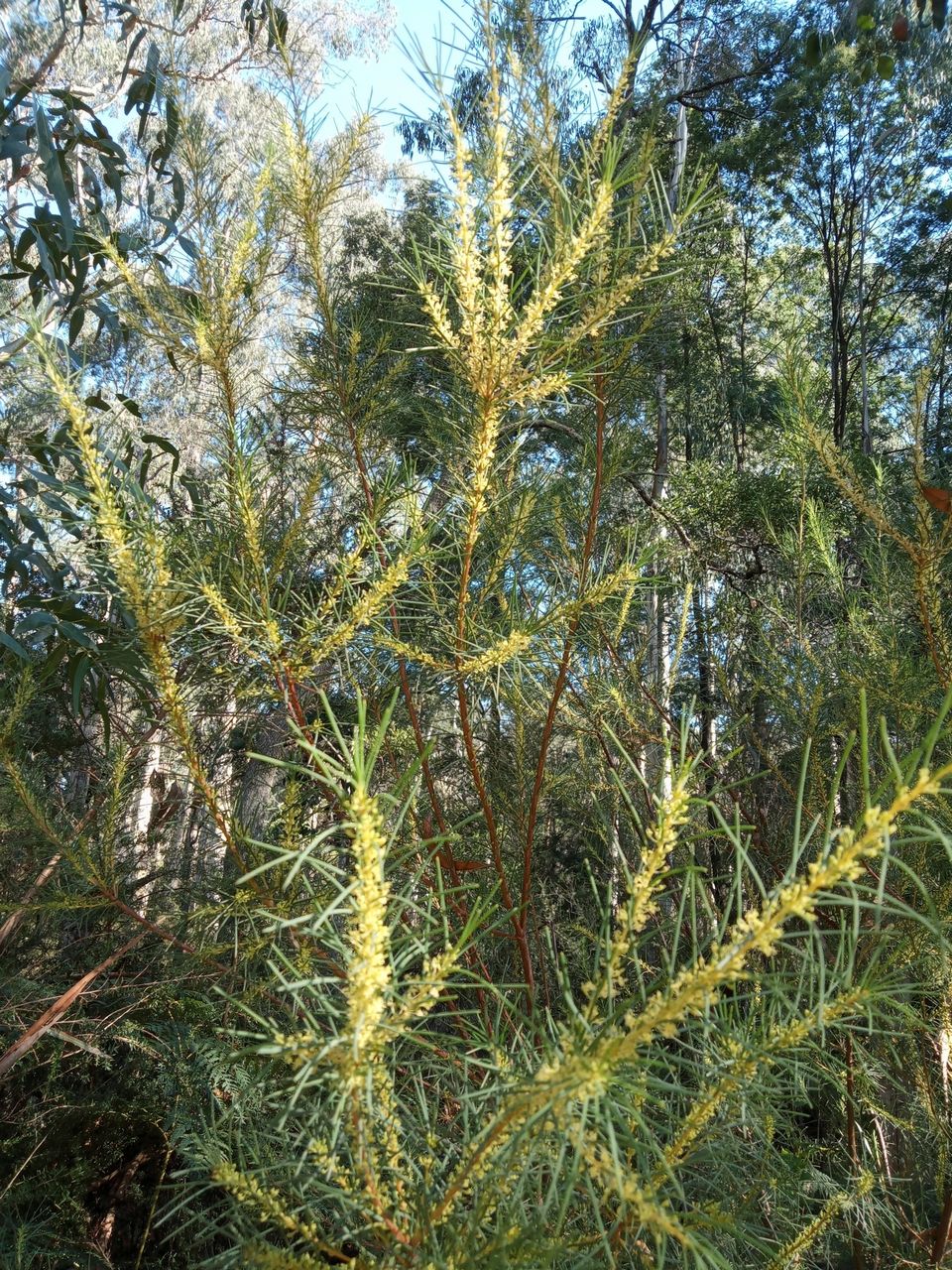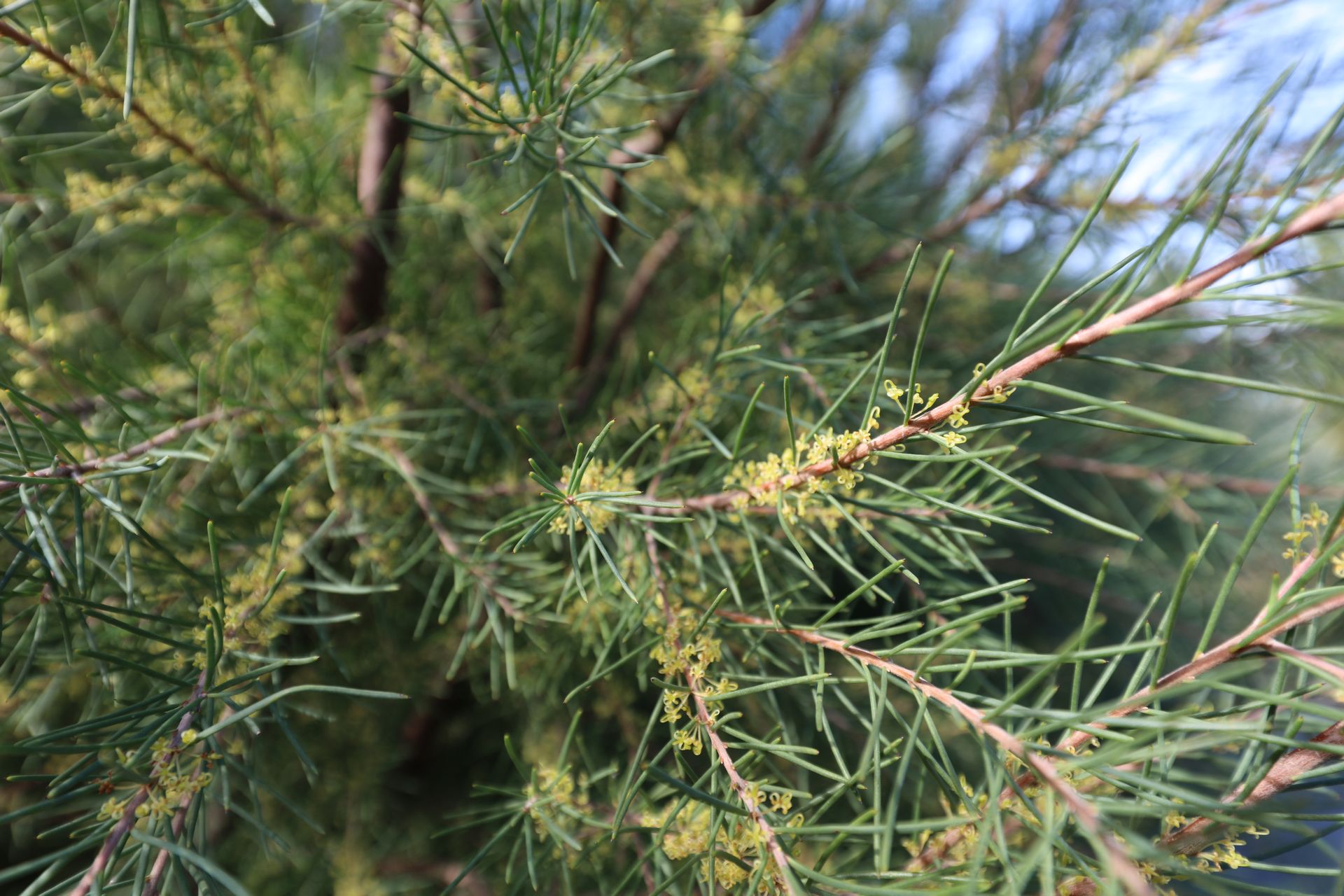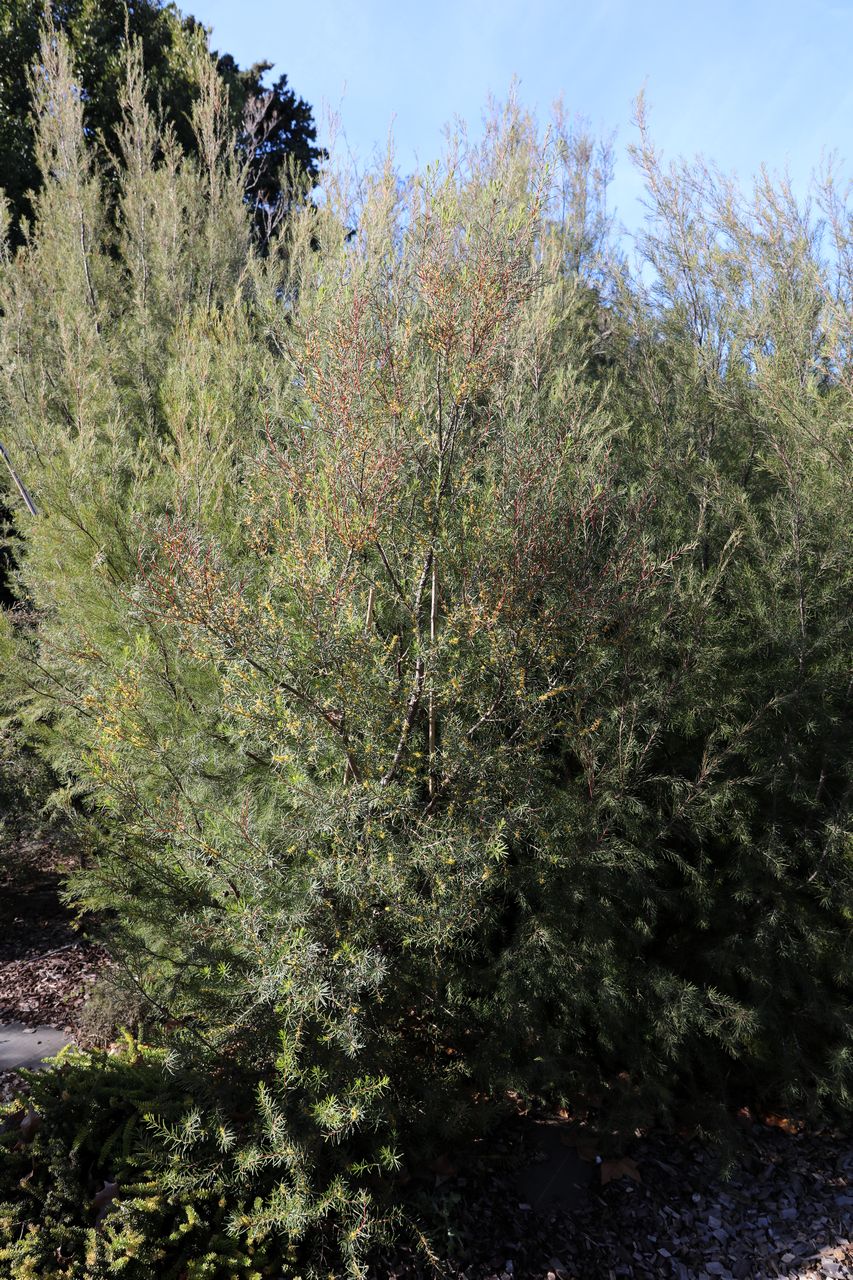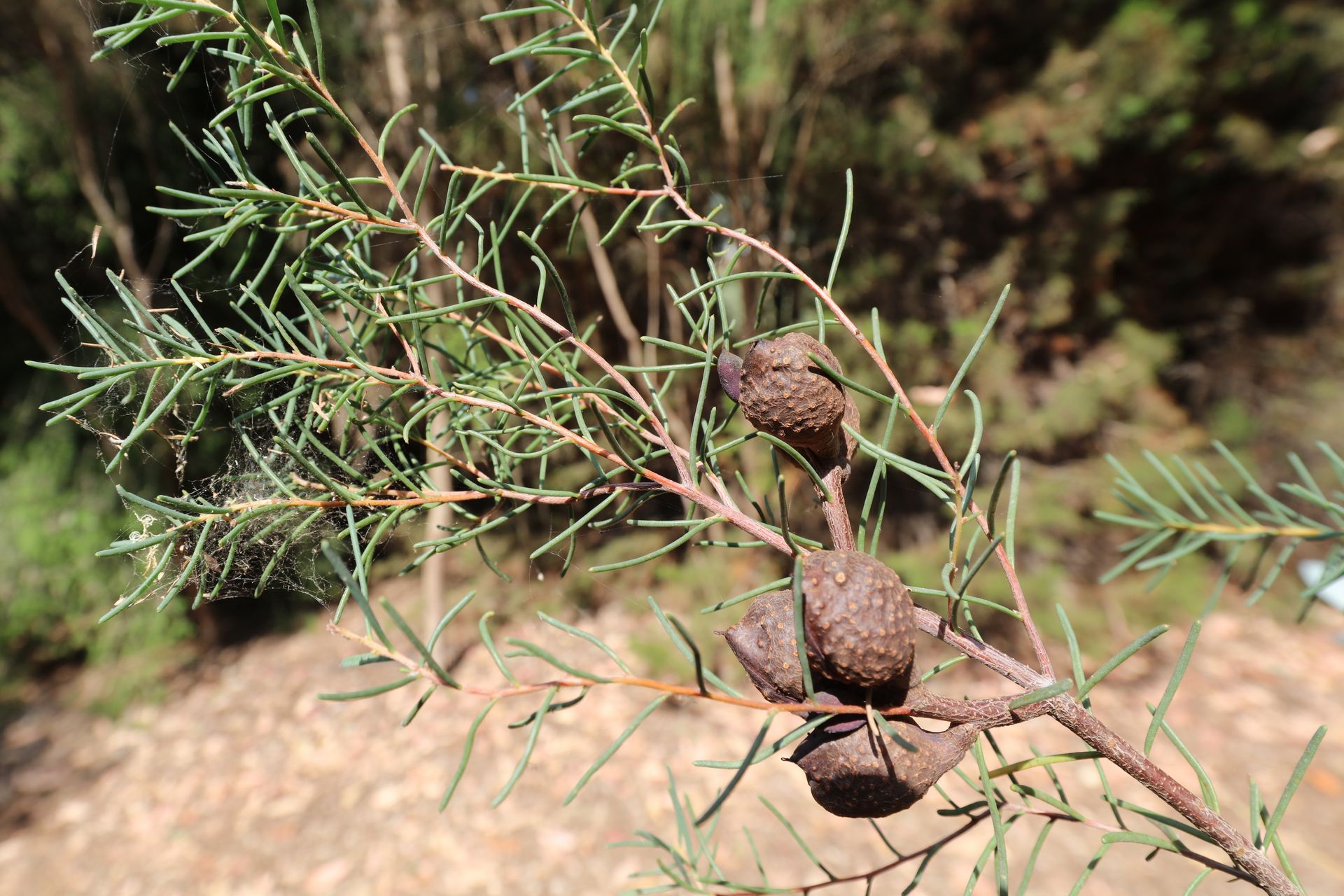Hakea nodosa 4880
Author: Robert Brown (1773-1858)Family: Proteaceae Subfamily: Grevilleoideae Tribe: Embothrieae Subtribe: Hakeinae
Genus: Hakea Section: Hakea Serie: Nodosa
English name: Yellow hakea
Zone: Australia
Description
This species occurs in south-eastern South Australia, Victoria and Tasmania, in closed heath and in swampy areas. The specific epithet is referring to the knobbly protuberances on the fruit.

Hakea nodosa Observed in Australia by rachel003 (license)
Botanical Description
It is a spreading, upright or rounded shrub, 2m high, lignotuberous or not. The branchlets are ribbed, soon or tardily glabrescent.
The leaves are terete to flattened, flexible, 0.8-5cm long, 0.7-2.5mm wide, glabrous, sometimes grooved below. The mucro is circa 0.2-0.9mm long.
The inflorescence is with 2-11 flowers. The rachis is simple, 0.5-1mm long, rarely up to 6 rachises developing on previous year's rachis, densely pubescent with appressed brown and/or white raised hairs. The flowers are cream-white to deep yellow. The pedicels are 1.5-3.3mm long, white-pubescent. The perianth is 1.3-2.2mm long, glabrous. The pistil is 3-4.5mm long. The gland is curved-rectangular.
The fruit is dimorphic, remaining closed if woody, opening if less woody, broadly ovate, 1.3-3.5cm long, 0.9-3cm wide, densely coarsely warty or almost smooth. The beak is short, oblique and broad, or sometimes narrow, decurrent down red-brown wood zone side only. The horns are absent. The seed is marginal, obliquely elliptic, 12-23mm long, 5.5-11mm wide. The wing is decurrent broadly 2/3 to whole way down on one side only, dark-grey to grey-yellow.
The leaves are terete to flattened, flexible, 0.8-5cm long, 0.7-2.5mm wide, glabrous, sometimes grooved below. The mucro is circa 0.2-0.9mm long.
The inflorescence is with 2-11 flowers. The rachis is simple, 0.5-1mm long, rarely up to 6 rachises developing on previous year's rachis, densely pubescent with appressed brown and/or white raised hairs. The flowers are cream-white to deep yellow. The pedicels are 1.5-3.3mm long, white-pubescent. The perianth is 1.3-2.2mm long, glabrous. The pistil is 3-4.5mm long. The gland is curved-rectangular.
The fruit is dimorphic, remaining closed if woody, opening if less woody, broadly ovate, 1.3-3.5cm long, 0.9-3cm wide, densely coarsely warty or almost smooth. The beak is short, oblique and broad, or sometimes narrow, decurrent down red-brown wood zone side only. The horns are absent. The seed is marginal, obliquely elliptic, 12-23mm long, 5.5-11mm wide. The wing is decurrent broadly 2/3 to whole way down on one side only, dark-grey to grey-yellow.

Member of
The Genus: Hakea Section: Hakea Serie: Nodosa having the following characters: Shrubs or more rarely, small trees, without corky bark. Leaves simple, terete (sometimes flattened in H. nodosa), not petiolate, not stem-clasping, sometimes grooved below; venation obscure. Inflorescence an axillary umbel, rarely resprouting in subsequent years, developing within involucre; bracts not persisting at base of inflorescence; rachis 0.6–2.5 mm long. Flowers 1–11 per umbel; pedicel pubescent. Perianth curved in bud, splitting to base into 4 distinct tepals, pubescent or glabrous. Pistil 3–4.5 mm long; pollen presenter an oblique disc; gland minute, U-shaped or rectangular. Fruit usually solitary, erect, retained on plant, woody (except sometimes in H. nodosa), tuberculate, beaked, horned or not, dehiscing fully down one side, mostly down other. Seed occupying part of valve; wing 1/2 way to ±fully down one side (red-brown wood) of seed body, not at all on other; seed body flanged on pale wood side or on both sides proximal to the wing.
A group of three species, found in S.A., N.S.W., Vic. and Tas.
A group of three species, found in S.A., N.S.W., Vic. and Tas.

Useful plant
Although with limited ornamental qualities, this species has value for its hardiness and adaptability to a wide range of soil types and conditions in temperate regions. A variant with greyish green foliage is fairly ornamental and a dwarf variant is popular with some enthusiasts. Plants grow fast, respond well to regular pruning or clipping and can be used for hedging.
References
- Encyclopedia of Australian Plants, Elliot W. Rodger & Jones David L. 2012 Vol. 5 pag. 219. ISBN
- Flora of Australia. profiles.ala.org.au/opus/foa/profile Vol. 17B pag. 66-67. Hakea nodosa
- Hakeas, a field and garden guide, Ivan Holliday. 2005 pag. 144-145. ISBN
- Native trees and shrubs of South-Eastern Australia, Leon Costermans. 1996 pag. 156. ISBN
- Novelties and Taxonomic Notes Relating to Hakea Sect. Hakea (Proteaceae), Mainly of Eastern Australia, W.R. Barker. Journal of the Adelaide Botanic Gardens 1996 Vol. 17 pag. 177-209. JStor
References
- Encyclopedia of Australian Plants, Elliot W. Rodger & Jones David L. 2012 Vol. 5 pag. 219. ISBN
- Flora of Australia. profiles.ala.org.au/opus/foa/profile Vol. 17B pag. 66-67. Hakea nodosa
- Hakeas, a field and garden guide, Ivan Holliday. 2005 pag. 144-145. ISBN
- Native trees and shrubs of South-Eastern Australia, Leon Costermans. 1996 pag. 156. ISBN
- Novelties and Taxonomic Notes Relating to Hakea Sect. Hakea (Proteaceae), Mainly of Eastern Australia, W.R. Barker. Journal of the Adelaide Botanic Gardens 1996 Vol. 17 pag. 177-209. JStor

References for the genus
- Encyclopedia of Australian Plants, Elliot W. Rodger & Jones David L. 2012 pag. 186-189. ISBN
- Australian Proteaceae: new taxa and notes, McGillivray, Donald. Telopea 1975 Vol. 1(1) pag. 19-32. DOI
- Flora of Australia. profiles.ala.org.au/opus/foa/profile Vol. 17B pag. 1-35. Hakea
- New species, new combinations and other name changes in Hakea (Proteaceae), Barker, RM. Journal of the Adelaide Botanic Garden 1990 pag. 95-110. JStor
- Novelties and Taxonomic Notes Relating to Hakea Sect. Hakea (Proteaceae), Mainly of Eastern Australia, W.R. Barker. Journal of the Adelaide Botanic Gardens 1996 Vol. 17 pag. 177-209. JStor
- Taxonomic notes on Hakea Schrader (Proteaceae), mainly relating to South Australia, Barker, WR. Journal of the Adelaide Botanic Garden 1985 pag. 233-247. JStor
- The Hakea pedunculata group of species (Proteaceae) and a new subspecies of Hakea stenophylla from Western Australia, Barker, R. M. Nuytsia: journal of the Western Australian Herbarium 1998 Vol. 12 pag. 1-8. Address
- Towards a revision of the Hakea epiglottis Labill.(Proteaceae) complex of Tasmania, Barker, RM. 1991 Vol. 124(2) pag. 79-84. Address
- The use of Trees and Shrubs in the Dry Country of Australia, Norman Hall. 1972 pag. 384-385. ISBN
- Australian Proteaceae: new taxa and notes, McGillivray, Donald. Telopea 1975 Vol. 1(1) pag. 19-32. DOI
- Flora of Australia. profiles.ala.org.au/opus/foa/profile Vol. 17B pag. 1-35. Hakea
- New species, new combinations and other name changes in Hakea (Proteaceae), Barker, RM. Journal of the Adelaide Botanic Garden 1990 pag. 95-110. JStor
- Novelties and Taxonomic Notes Relating to Hakea Sect. Hakea (Proteaceae), Mainly of Eastern Australia, W.R. Barker. Journal of the Adelaide Botanic Gardens 1996 Vol. 17 pag. 177-209. JStor
- Taxonomic notes on Hakea Schrader (Proteaceae), mainly relating to South Australia, Barker, WR. Journal of the Adelaide Botanic Garden 1985 pag. 233-247. JStor
- The Hakea pedunculata group of species (Proteaceae) and a new subspecies of Hakea stenophylla from Western Australia, Barker, R. M. Nuytsia: journal of the Western Australian Herbarium 1998 Vol. 12 pag. 1-8. Address
- Towards a revision of the Hakea epiglottis Labill.(Proteaceae) complex of Tasmania, Barker, RM. 1991 Vol. 124(2) pag. 79-84. Address
- The use of Trees and Shrubs in the Dry Country of Australia, Norman Hall. 1972 pag. 384-385. ISBN
General specifications
Biological type: shrub
Frost resistance: 18ºF
Leaf color: dark green
Flower color: yellow
No transplantation: Yes
Specifications for the Mediterranean basin
Adult size (h x w): 13,1ft x 9,8ft
Sun exposure: part sun (Sun hours: >3h <6h Foliage: evergreen
Growth: fast
Flowering time from November until February
Ripe fruits from June until November
Specific information for our garden
Planting substrate: 30%Compost+30%Coco+40%Sand
Plant watering: 3x a week pH 6.5
Logical sequence of containers for: Heathers; forestry plate, forestry pot 3L, Airpot 12L, Airpot 50L
Propagation is done by cuttings
Units in the garden: 1x
Ecology in its country of origin
Rainfall: 600-900mm
Clay soil: a little
Sandy soil: much
Frost resistance: 18ºF
Leaf color: dark green
Flower color: yellow
No transplantation: Yes
Specifications for the Mediterranean basin
Adult size (h x w): 13,1ft x 9,8ft
Sun exposure: part sun (Sun hours: >3h <6h Foliage: evergreen
Growth: fast
Flowering time from November until February
Ripe fruits from June until November
Specific information for our garden
Planting substrate: 30%Compost+30%Coco+40%Sand
Plant watering: 3x a week pH 6.5
Logical sequence of containers for: Heathers; forestry plate, forestry pot 3L, Airpot 12L, Airpot 50L
Propagation is done by cuttings
Units in the garden: 1x
Ecology in its country of origin
Rainfall: 600-900mm
Clay soil: a little
Sandy soil: much
Sowing instructions
SPRING Keep in refrigerator at 39°F for 8 weeks in dry condition. Sow the seeds at 2mm depth in the Well Drained Seed Sowing Mix between 64-72°F. During germination keep the substrate moist and in daylight. The seeds germinate in 3-6 weeks.
The average seed weight is 71,5 per gram (0,01398g).
Cuttings instructions
Take the cuttings in early fall. Soak them in a hormonal preparation for cuttings before planting them in a substrate composed of 50% perlite and 50% heather earth. Keep them sufficiently moist at a temperature of 20°C in sealed freezer bags. Keep the light on for 16 hours a day.
The average seed weight is 71,5 per gram (0,01398g).
Cuttings instructions
Take the cuttings in early fall. Soak them in a hormonal preparation for cuttings before planting them in a substrate composed of 50% perlite and 50% heather earth. Keep them sufficiently moist at a temperature of 20°C in sealed freezer bags. Keep the light on for 16 hours a day.
Experiences in the garden
16-09-16A Obtaining seeds from seed provider Nindethana Seeds collected in 'Nindethana Seeds5>Grampians National Park'. (Wild origin)
07-11-16 Send a batch to nursery Railhet.
28-04-17B Obtaining 6 plants from nursery Arven
04-08-22 2x Dead plant because of watering problem: JTAust1.
28-09-23 1x Dead plant: No information: JTAust1.
19-12-24 2x Dead plant due to root competition: JTAust.
28-05-25 1x Dead plant: End of life: JTAust.
26-10-17A Obtaining 5 plants from nursery Railhet, they are planted in zone(s) JTAust1 (Formerly of wild origin)
04-08-22 1x Dead plant because of watering problem: JTAust1.
28-09-23 2x Dead plant: No information: JTAust1.
19-12-24 1x Dead plant due to root competition: JTAust.
04-09-19A Collection of scions in the garden . (Formerly of wild origin)
. . . 2019A Production of 3 plants in our nursery (Formerly of wild origin)
25-08-20 1x Dead plant because of substrate problem: Serre8 Gt.
24-06-21 1x Dead plant: No information: Serre3 F3.
04-10-24 1x Plant not found in nursery: Petit29 F3.
14-12-20C Obtaining seeds from seed provider Villa Thuret.
14-04-21 Sown 12 seeds in a seed plate F and germinated at 19-05-21 in Serre3.
Protocol: Spring Strat Hum XXX 2mm Sowing mix+Sand 64-72°F Damp substrate+Light 3-6w
. . . 2020B Collection of seeds in the garden collected at 26-06-20. Stock
02-03-21 Send a batch to nursery APS.
26-04-21 Sown 20 seeds in a seed plate F and germinated at 26-05-21 in Serre3.
Protocol: Spring Strat Hum XXX 2mm Sowing mix+Sand 64-72°F Damp substrate+Light 3-6w
18-01-22 Send a batch to nursery Antoniazzi.
. . . 2021B Collection of seeds in the garden collected at 09-06-21. Stock
. . . 2021C Production of 8 plants in our nursery: Petit29 6x F3
27-06-25 1x Dead plant because of cold and humidity in winter: Petit29 F3.
06-06-25 1x Dead plant due to too much rain: Petit29 F3.
. . . 2021B Production of 17 plants in our nursery: Petit29 3x F3 Petit24 1x C6
24-01-24 4x Dead plant: No information: Petit29 F3.
27-07-23 2x Dead plant because of substrate problem: Petit29 F3.
28-12-23 3x Dead plant: No information: Petit29 F3.
04-10-24 4x Dead plant because of watering problem: Petit29 F3.
. . . 2022A Collection of seeds in the garden collected at 21-06-22. Stock (Formerly of wild origin) Index Seminum
11-05-23 Sown 6 seeds in a seed plate F and germinated at 13-06-23 in Serre3.
Protocol: Spring Strat Dry 8wk 2mm Sowing mix+Sand 64-72°F Damp substrate+Light 3-6w
. . . 2023A Production of 5 plants in our nursery: Petit29 4x F2 (Formerly of wild origin)
04-10-24 1x Dead plant because of watering problem: Petit29 F2.